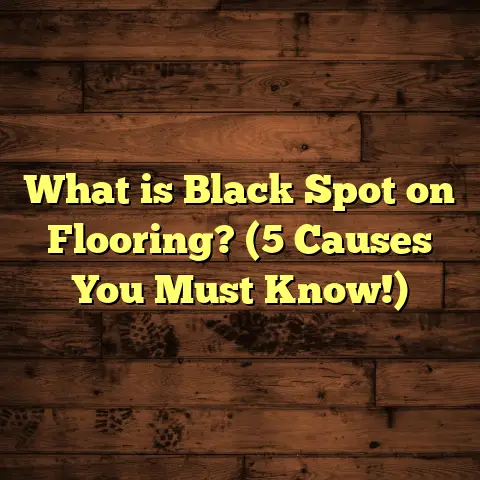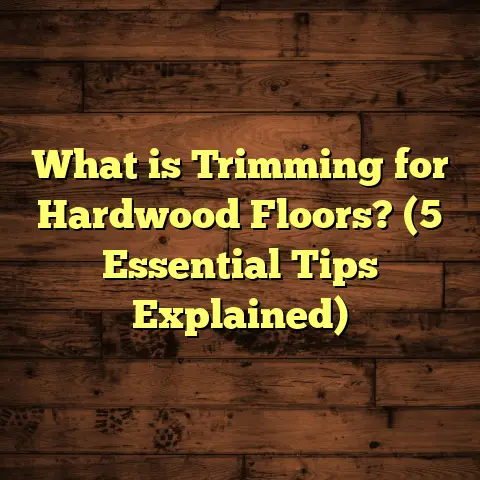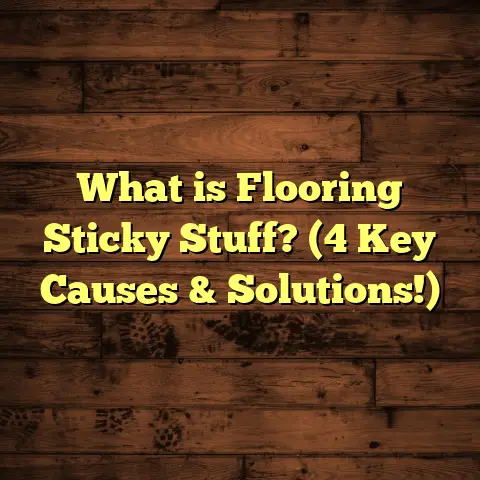What Is a Valley Floor? (5 Key Features You Should Know)
Starting a flooring project can get confusing fast. I remember the time when I was working on a house renovation in the foothills, trying to explain to the homeowner why the floor plan needed to consider the valley floor of the land. They kept asking, “What exactly is a valley floor?” It’s a simple question but has a lot of depth, especially for anyone involved in construction, landscaping, or even just curious about geography.
So, what is a valley floor? Let me break it down and share some key features you should know. By the end, you’ll see why understanding this concept is more than just academic—it’s practical and vital for many projects.
What Is a Valley Floor?
A valley floor is basically the flat or gently sloping bottom part of a valley. Imagine a long dip between hills or mountains; that lowest stretch where water often flows or collects—that’s the valley floor. It’s where sediments settle, plant life thrives, and sometimes, human settlements develop.
I like to think of it as the “heart” of the valley because it’s where most of the activity happens. The ground here tends to be softer and richer compared to the steep sides. This area plays a huge role in how water moves through a landscape and how ecosystems function.
Valley floors can vary widely depending on their location and the type of valley. Some are wide with expansive floodplains, while others are narrow and rocky. But their core characteristics remain surprisingly consistent across different environments.
When I first encountered valley floors outside my usual urban projects, I realized how much their features influence everything from soil conditions to building requirements. For example, the difference between installing hardwood flooring on a valley floor property versus a hillside home can be dramatic because of moisture levels and soil stability.
How Valleys Form and What Creates a Valley Floor
Understanding valley floors also means looking at how valleys themselves form. Most valleys develop through erosion by rivers or glaciers over thousands or millions of years.
- River Valleys: These valleys form as rivers cut down through rock and soil, carrying sediments downstream. Over time, the river deposits these sediments on the valley floor during floods or periods of slower water flow.
- Glacial Valleys: Created by glaciers carving through land, these tend to have U-shaped cross-sections with flat bottoms—classic valley floors.
This formation process explains why valley floors tend to have rich alluvial soils—they’re essentially built up by layers of sediment deposited over time.
5 Key Features You Should Know About Valley Floors
1. Flat or Gently Sloping Terrain
One thing I always notice when visiting different valleys is how the floor is usually pretty flat compared to the slopes on either side. This flatness happens because of sediment deposits over time.
Why does this matter? Well, flat terrain makes valley floors ideal spots for farming, housing, and infrastructure. For example, in my work with clients building homes near river valleys, we always pay attention to how flat the valley floor is because it affects drainage and foundation stability.
According to geologists, valley floors can have slopes as gentle as 0.1% to 2%, which is why water flow tends to slow down here, allowing sediments like sand, silt, and clay to settle.
When I helped design flooring solutions for a lakeside cabin built on such a terrain, the nearly level ground meant we could install radiant heat flooring easily without worrying about uneven settling.
Flat terrain also means easier accessibility for construction equipment and materials—a big plus during any building project.
2. Rich Soil and Sediment Deposits
Valley floors are usually packed with nutrient-rich soils. This happens because rivers and streams carry sediments down from the hillsides and deposit them here. Over thousands of years, these deposits build up deep layers of fertile soil.
I’ve worked on farms located on valley floors where crops thrived without heavy chemical fertilizers—just natural soil richness doing its job.
Statistics from agricultural studies show that valley floor soils can have up to 40% more organic matter than nearby upland soils. This makes them prime locations for agriculture and gardening projects.
Here’s an interesting fact: The Mississippi River Valley in the United States has some of the most fertile valley floors globally due to thick layers of sediment deposited over millennia.
The sediment layers not only create fertile soil but also influence groundwater recharge rates—making valley floors vital for both farming and ecosystem balance.
I remember visiting a vineyard on a Mediterranean valley floor where the unique soil composition gave grapes distinct flavors—something that wouldn’t be possible without the sediment buildup characteristic of valley floors.
3. Water Availability and Drainage Patterns
One feature that’s impossible to ignore is how water behaves on valley floors. These areas often serve as natural pathways for rivers, streams, or even underground water flow.
This has practical implications. For instance, I once helped design a drainage system for a property sitting on a broad valley floor prone to flooding during heavy rains. Understanding where water naturally collects helped us place drains and retention ponds effectively.
Valley floors also usually have higher water tables. Data from hydrology research indicates that water tables here can be several meters closer to the surface compared to surrounding hillsides.
This closeness to groundwater means moisture control is critical when installing flooring in homes built on valley floors. Without proper vapor barriers or subfloor ventilation, moisture can cause warping or mold problems—something I’ve had to tackle multiple times in my career.
In addition to drainage concerns, valley floors often act as natural floodplains. During heavy rain or snowmelt, water spreads across these areas before moving downstream.
I once worked on a restoration project that involved converting an old floodplain on a valley floor back into a natural wetland area—this helped reduce flood risk downstream while improving local biodiversity.
4. Vegetation and Wildlife Habitats
The combination of flat land, rich soil, and ample water makes valley floors hotspots for vegetation growth and wildlife habitats.
From my personal experience hiking through different valleys, I noticed lush grasses, wildflowers, and trees thriving on valley floors, supporting diverse animals like deer, birds, and small mammals.
Ecologists report that biodiversity on valley floors can be 20-30% higher than on adjacent uplands due to these favorable conditions.
These vegetative characteristics also influence landscaping choices around homes built on valley floors. It’s common for homeowners to incorporate native plants adapted to moist soils into their yards—which helps with erosion control while attracting local wildlife.
I’ve seen clients create beautiful natural gardens using species native to their valley floor environment, which reduced maintenance needs and boosted curb appeal.
5. Vulnerability to Flooding and Human Impact
While valley floors have many benefits, they also come with risks—especially flooding. Because they collect water from surrounding slopes, they can flood during heavy storms or rapid snowmelt.
In one project near a mountain valley, I advised clients on flood-proofing their home after reviewing floodplain maps showing past flood events covering much of the valley floor.
Human development on valley floors can disrupt natural water flow and increase flood risks too. Urbanization often leads to more impervious surfaces like concrete, reducing natural absorption.
That’s why smart planning is essential when building or landscaping on a valley floor—to balance human needs with nature’s patterns.
Flooding risk also affects flooring choices inside buildings on valley floors. In areas prone to occasional flooding, I recommend avoiding hardwood flooring at ground level in favor of tile or vinyl options which hold up better under moisture exposure.
My Experience with Valley Floors in Flooring and Construction Projects
When I first started contracting, I didn’t fully appreciate how much the geography beneath a building could affect everything from foundation work to flooring choices. Then I worked on a project where the house was built right on a narrow valley floor near a creek.
The soil was alluvial—rich but soft—which made standard concrete slab foundations tricky. We had to use special soil stabilization techniques before laying down hardwood floors inside. If we ignored the valley floor conditions, cracks or moisture damage would have been inevitable.
I learned that understanding valley floor features isn’t just about geography; it directly impacts construction practices—especially flooring installation.
For example:
- Moisture levels tend to be higher in these areas.
- Subfloor materials need careful selection.
- Drainage solutions must be integrated into design plans.
One memorable case involved installing engineered hardwood flooring over a crawl space in a home built on a valley floor prone to dampness. We incorporated moisture barriers beneath the crawl space and selected wood species known for better moisture resistance like white oak. The result was a durable floor that maintained its beauty despite environmental challenges.
In another project near an agricultural valley floor, we faced issues with soil movement due to seasonal flooding. Here I advised clients to use floating laminate flooring systems that allow slight expansion without cracking—a solution tailored specifically for conditions common in valley floors.
Technical Insights: Soil Types and Their Impact on Construction
Valley floors often have distinct soil types compared to upland areas:
- Alluvial Soils: These are common on river valley floors and consist mainly of sand, silt, clay, and organic material deposited by flowing water.
- Loam: A well-balanced mix of sand, silt, clay found in some fertile valleys.
- Peaty or Organic Soils: Found in wetter valleys where plant material accumulates faster than it decomposes.
Each soil type affects foundation design differently:
- Alluvial soils can be unstable if saturated.
- Clayey soils expand and contract with moisture changes causing shifting.
- Peaty soils have low bearing capacity needing special support.
During one project on a soft alluvial soil valley floor near a riverbank, we used deep pier foundations combined with moisture-resistant subfloor materials to prevent shifting issues—this combination worked well over years of observation.
Valley Floors and Climate Influence: How Weather Shapes These Spaces
Climate plays an important role in shaping valley floor conditions:
- In humid climates, higher rainfall increases flooding risk but supports lush vegetation.
- In arid regions like desert valleys, water availability limits vegetation but sediment deposits still create flat valley floors.
- Snowmelt in mountainous valleys leads to seasonal flooding affecting soil moisture cycles dramatically.
For example, in Colorado’s mountainous valleys that have snowy winters followed by spring melts, homes built on valley floors need robust drainage systems integrated into foundation design—something I’ve done repeatedly after consulting local climate data.
Comparing Valley Floors With Similar Geographical Features
You might wonder how a valley floor stacks up against other landforms like plateaus or hillsides when it comes to building or farming.
| Feature | Valley Floor | Hillside | Plateau |
|---|---|---|---|
| Terrain | Flat or gently sloping | Steep slopes | Flat or gently sloping |
| Soil Richness | High (alluvial deposits) | Variable; often thinner soils | Often shallow soils |
| Water Availability | High (streams/rivers often present) | Lower; runoff drains downhill | Variable; may depend on rainfall |
| Flood Risk | Higher due to water collection | Lower | Low to moderate |
| Construction Challenges | Moisture control critical | Erosion control critical | Foundation stability important |
From my projects, valley floors tend to offer easier construction access but demand more attention to moisture control than hillsides or plateaus.
Hillsides require terracing and erosion control measures which can increase costs but often pose less flood risk than valley floors.
Plateaus provide stable ground but may lack easy access to water resources found abundantly in valleys.
If you’re deciding where to build or plant crops, these differences can help guide your choices based on your priorities—whether it’s ease of construction or water availability.
Case Study: A Flooring Contractor’s Challenge on a Mountain Valley Floor
Let me share one detailed case from my own work that highlights why understanding valley floors matters so much in practice:
I was called in by homeowners building in a mountain town nestled in a narrow river valley. Their house sat directly on the valley floor next to the creek. Early signs showed moisture seeping into their basement flooring area during spring thaw.
After assessing soil samples and hydrology maps, we confirmed that seasonal groundwater rise was causing dampness beneath their flooring system—a classic issue for homes built on such terrain.
Here’s what we did:
- Installed advanced vapor barriers under the concrete slab.
- Added perimeter drainage around the foundation.
- Selected engineered hardwood with better moisture resistance.
- Designed subfloor ventilation openings for airflow control.
The cost was higher but saved them from future repairs caused by mold or wood warping.
This project taught me firsthand that knowing about valley floor conditions isn’t optional—it’s necessary for long-term success in construction and flooring installation.
Practical Tips If You’re Building or Renovating on a Valley Floor
If you find yourself working with properties located on valley floors—whether building new structures or renovating existing ones—here are some practical tips based on my years of experience:
- Conduct thorough soil testing: Don’t skip this step as it informs foundation design.
- Plan for moisture management: Use vapor barriers, drainage systems, and moisture-resistant materials.
- Consider flood risk: Check floodplain maps; elevate living spaces if needed.
- Select appropriate flooring: Engineered hardwoods or tiles suit moist environments better than traditional hardwoods.
- Use native plants for landscaping: They help stabilize soil and reduce water runoff problems.
- Work with local experts: Geologists or hydrologists familiar with your area can provide valuable insights.
Applying these steps can save money and stress down the road while improving durability and comfort inside your home.
Unique Insights: The Role of Valley Floors in Cultural Development
Valley floors have not just geological but cultural significance worldwide. Many ancient civilizations settled along fertile river valleys because these flat areas offered food security and easy access to water routes.
For example:
- The Nile River Valley supported ancient Egyptian civilization with its predictable flooding cycles enriching farmland.
- The Indus Valley Civilization thrived similarly due to fertile plains.
These historical examples highlight how humans have long understood and utilized the benefits of valley floors despite their challenges like flooding risk.
In modern times, this understanding translates into urban planning concepts such as greenbelts along rivers or floodplain zoning regulations designed around natural topography including valleys.
The Environmental Importance of Preserving Valley Floors
Preserving natural valley floors matters beyond construction concerns:
- They act as natural buffers absorbing floodwaters.
- Support wetlands critical for biodiversity.
- Filter pollutants from runoff before entering rivers.
Development pressures threaten these functions through paving over soils or draining wetlands. Responsible land use planning must respect these ecological roles while balancing human needs.
I’ve worked with environmental groups promoting restoration projects that return damaged valley floors back to natural states—improving ecosystem health while reducing disaster risks downstream.
How Technology Helps Us Understand Valley Floors Better
Modern tools like GIS (Geographic Information Systems), drones with LIDAR scanning, and ground-penetrating radar help map valley floor features precisely today more than ever before.
When working on complex projects recently, I used drone surveys combined with soil moisture sensors to create detailed site analyses before recommending flooring solutions tailored exactly to site conditions rather than guesswork.
This kind of data-driven approach improves planning accuracy dramatically—which ultimately benefits everyone involved by reducing surprises during construction phases.
Comparing Flooring Options Suitable for Valley Floor Homes
Given all these factors related to moisture and soil composition typical of valley floors, choosing suitable flooring materials becomes crucial:
| Flooring Type | Suitability for Valley Floor Homes | Pros | Cons |
|---|---|---|---|
| Solid Hardwood | Moderate – prone to moisture damage unless treated | Natural look & feel | Warping risk if moisture not controlled |
| Engineered Hardwood | High – better resistance due to layered construction | Durable & stable | Can be costlier than laminate |
| Laminate Flooring | Moderate – depends on quality & moisture barrier usage | Affordable & wide styles | Susceptible if exposed to standing water |
| Vinyl Flooring | High – waterproof options available | Waterproof & easy maintenance | Less natural appearance |
| Tile Flooring | Very High – excellent moisture resistance | Durable & waterproof | Cold underfoot unless heated |
| Carpet | Low – absorbs moisture easily | Warmth & comfort | Mold risk if damp |
My preference when working on homes built directly on moist valley floors tends toward engineered hardwood or tile because they balance aesthetics with durability against moisture challenges.
Final Thoughts on Valley Floors: What You Should Take Away
Valley floors are fascinating landforms full of life-giving qualities but also natural challenges—especially related to water management and construction durability. From my personal projects and years in construction contracting focused partly on flooring installation across varied terrains, understanding what makes these areas unique has saved me numerous headaches—and helped clients avoid costly mistakes.
They offer:
- Flat terrain ideal for building
- Rich soils perfect for agriculture
- Abundant water resources supporting ecosystems
- Unique challenges around flooding & moisture
Compared to hillsides or plateaus where erosion or access might dominate concerns instead of flooding risks, working with valley floors means respecting their natural hydrology is key.
If you’re considering development there—or just curious about nature’s design—I hope sharing my experiences brought clarity about what exactly a valley floor is—and why it matters far beyond geography class!
Have you encountered any interesting challenges related to building or gardening in such locations? I’d love to hear your story!





